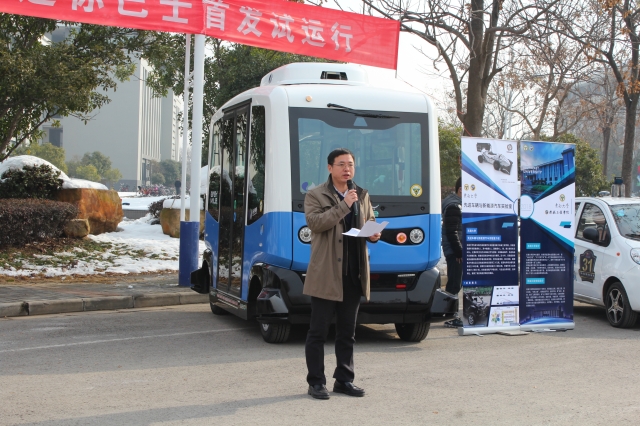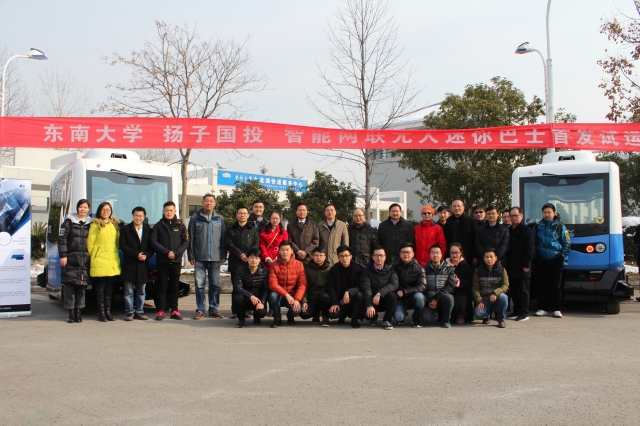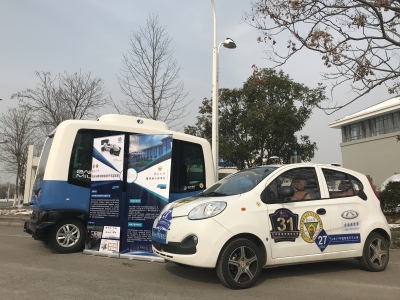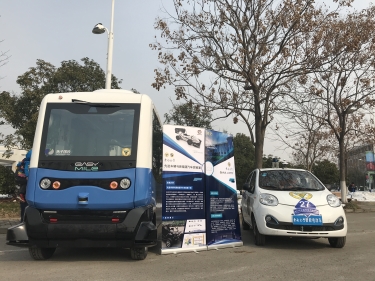On the morning of February 2nd, 2018, Southeast University and Nanjing Yangzi State-owned Investment Group Co., Ltd. jointly launched the first trial run of the cooperative operation’s first domestic smart network unmanned minibus at Southeast University Jiulonghu Campus. Professor Wu Gang, vice president of Southeast University, chairman of Yangtze International Investment Group Long Cai, Zhisheng Zhang, secretary of the party committee of the mechanical engineering institute, head of school related department and all members of the bus operations team participated in the first commissioning event. The conference was presided over by Prof. Guodong Yin, vice president of the mechanical engineering institute.


Southeast University and Nanjing Yangzi State-owned Investment Group signed a memorandum of strategic cooperation to jointly build a smart network-linked transportation research platform last year. The aim is to build a national-level intelligent network-linked traffic demonstration area. As the first batch of key projects of “Jiangbei New Area Intelligent Network-Linked Transportation”, the construction of the “unmanned minibus” demonstration area has officially started. In the early stage, Southeast University and Yangzi SDIC completed the worldwide investigation and expert demonstration of the most advanced equipment systems in this field. The intelligent network connected unmanned minibus for the first trial operation was tailor-made by Yangzi SDIC according to the development needs of the intelligent network-linked traffic demonstration area. The related research team of the School of Mechanical Engineering of Southeast University will be responsible for the post-operation management, scientific research platform construction, and the redevelopment of intelligent network-linked automotive technology.


The first trial run mini bus is a six-seater electric bus with a length of 4m, a width of 2m and a height of 2.9m.It can accommodate a maximum of 12 passengers. There is no steering wheel in the car and it can be driven in both directions symmetrically. The minibus has a full load of about 3000kg. At the same time, it is currently designed with a maximum speed of 20km/h and equips with a 15.36 kWh lithium iron phosphate battery. An average of 7 hours full charge can achieve 14 hours of pure electric driving. During the operation of the driverless minibus, the on-duty safety officer will be equipped on the entire line to ensure that unexpected situations are handled in a timely manner. The “mini-transport bus” powered by batteries for the driverless minibus not only conforms to environmental protection in terms of energy, but also embodies the concept of “circular economy, low-carbon travel” for the city’s circular development.


It is reported that the team responsible for the operation and maintenance of the smart network unmanned minibus all comes from the advanced vehicle and new energy vehicle laboratory of the Southeast University, which belongs to the school of mechanical engineering. The laboratory relied on Southeast University aims to create a "Strong Engineering" development strategy. With the strong support of the Mechanical Engineering Institute, it recently has undertaken or completed more than 30 projects including the National Natural Science Foundation of China, national major projects, and achievements in Jiangsu Province. Based on the smart network unmanned mini bus, Southeast University will combine the school's dominant disciplines to focus on the development of intelligent network-linked automotive-related cutting-edge technologies and applications. It will establish an intelligent network-linked transport system experimental platform with full automation, complete communications, precise positioning, stable control, and provide the basis for scientific research on human-vehicle-road collaborative intelligent network-linked transport systems. Not only V2X vehicle networking technology based on DSRC or LTE-V communication technology but also researches on multi-vehicle cooperative operation and cooperative control of traffic intersections at traffic intersections based on vehicle interconnection communication technology will be carried out.
(Author: Hao Liu, TianLiu, Weichao Zhuang)

